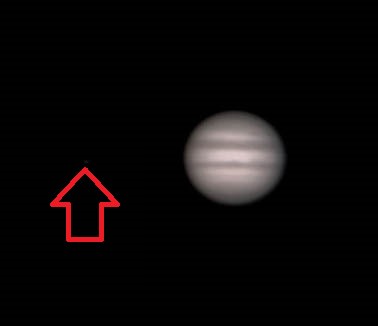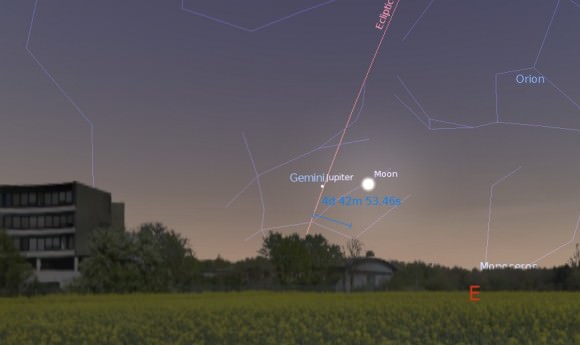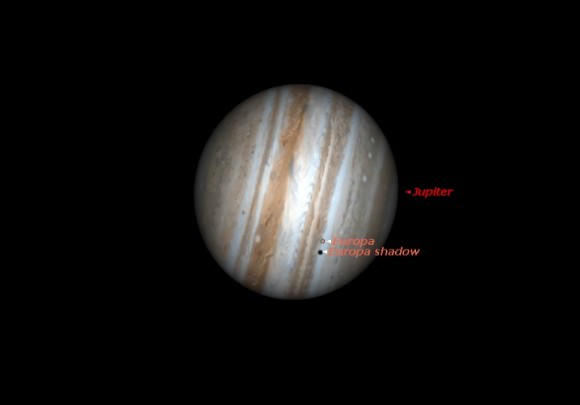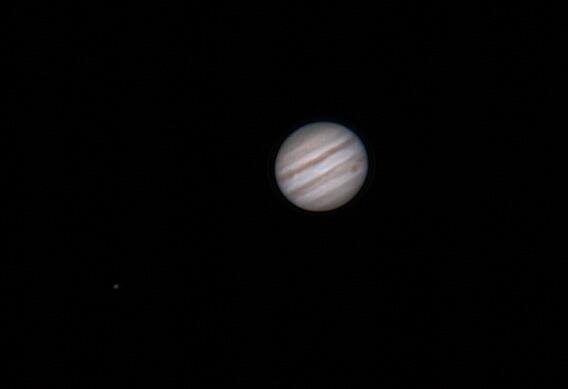Lovers of planetary action rejoice; the king of the planets is returning to the evening skies.
One of the very first notable astronomical events for 2014 occurs on January 5th, when the planet Jupiter reaches opposition. You can already catch site of Jove in late December, rising in the east about an hour after local sunset. And while Venus will be dropping faster than the ball in Times Square on New Year’s Eve to the west in early 2014, Jupiter will begin to dominate the evening planetary action.
Orbiting the Sun once every 11.9 years, oppositions of Jupiter occur about once every 13 months or about 400 days, as the speedy Earth overtakes the gas giant on the inside track. This means that successive oppositions of the planet move roughly one astronomical constellation eastward. In fact, this year’s opposition is it’s northernmost in 12 years, occurring in the constellation Gemini. “Opposition” means that an outer planet is rising “opposite” to the setting Sun. As this opposition of Jupiter occurs just weeks after the southward solstice, Jupiter now lies in the direction that the Sun will occupy six months from now during the June Solstice.
This all means that Jupiter will ride high in the sky for northern hemisphere observers towards local midnight, a boon for astrophotographers looking to catch the planet high in the sky and out of the low horizon murk.
Jupiter will reach its most northern point for 2014 at a declination of +23.3 degrees on March 11th.
Jupiter also “skipped” 2013, in the sense that it was an “oppositionless year” for the giant world, as said 13 month span fell juuusst right, first on December 2nd, 2012 and then on January 5th, 2014. The next opposition of Jupiter will occur on… you guessed it… February 6th, 2015. The last year missing an opposition of Jupiter was 2001.

The exact timing of Jupiter’s opposition to the Sun in right ascension occurs at 21:00 UT/4:00 PM EST on January 5th. Its closest approach to Earth, however, arrives 27 hours prior, owing to a slight outward curvature of the approach of the two worlds. Jupiter will then lie about 4.21 astronomical units (AUs) or 629 million kilometres distant. This is just about down the middle of how close it can pass; Jupiter was just under 4 AUs distant in September 2010, and can pass almost 4.5 AUs from Earth, as happened in April 2005.
Jupiter also reaches a maximum brightness of magnitude -2.7 at opposition in 2014 and presents a disk 46.8” arc seconds wide. The coming month also provides a great chance to catch Jupiter in the daytime sky just before sunset, when the waxing gibbous Moon passes 4.9 degrees south of the planet on the evening of January 14th.

The very first thing you’ll notice looking at Jupiter, even at low power with binoculars or a telescope, is it retinue of moons. Though the planet has 67 discovered moons and counting, only the four large Galilean moons of Io, Europa, Ganymede and Callisto are readily apparent in a telescope. It’s fun to see orbital mechanics in action and watch them from night to night as they change position, just as Galileo first did over four centuries ago. This provided him with evidence that there is much more to universe than meets the eye, though we can consider ourselves fortunate that his proposal to name them the “Medician Moons” after his Medici benefactors was never widely adopted.
Crank up the magnification, and you’ll notice the large twin stripes of the northern and southern equatorial cloud belts crossing the disk of Jupiter. While the northern belt is stable, the southern belt has been known to submerge and disappear from view about every decade or so, as last happened in 2009-2010. You’ll also notice the Great Red Spot, a massive storm system over three times larger than the Earth that has been tracked by astronomers since it was recorded by Samuel Schwabe in 1831. The planet has the fastest rotation of any world in our solar system at 9.9 hours, and you’ll notice this swift rotation tracking Jupiter over the course of a single evening.
Transits and occultations of Jupiter’s moons are also always interesting to watch. The variation in the timing of these events at differing distances led Danish astronomer Ole Rømer to make the first attempts at measuring the speed of light in 1676.

It’s interesting to note that Jupiter and its moons cast a shadow nearly straight back from our line of sight around opposition. You can see this change as the planet heads towards quadrature on April 1st, 2014 and Jupiter and its moons cast shadows off to one side. We’re also in the midst of a plane crossing, as the orbits of the Jovian moons appear edge-on to our line of sight in 2014 headed into early 2015. The outermost Jovian moon Callisto began a series of transits in 2013 and will continue to do so through 2014.
This is a great time to begin following all of the Jovian action, as we head into another exciting year of astronomy!

